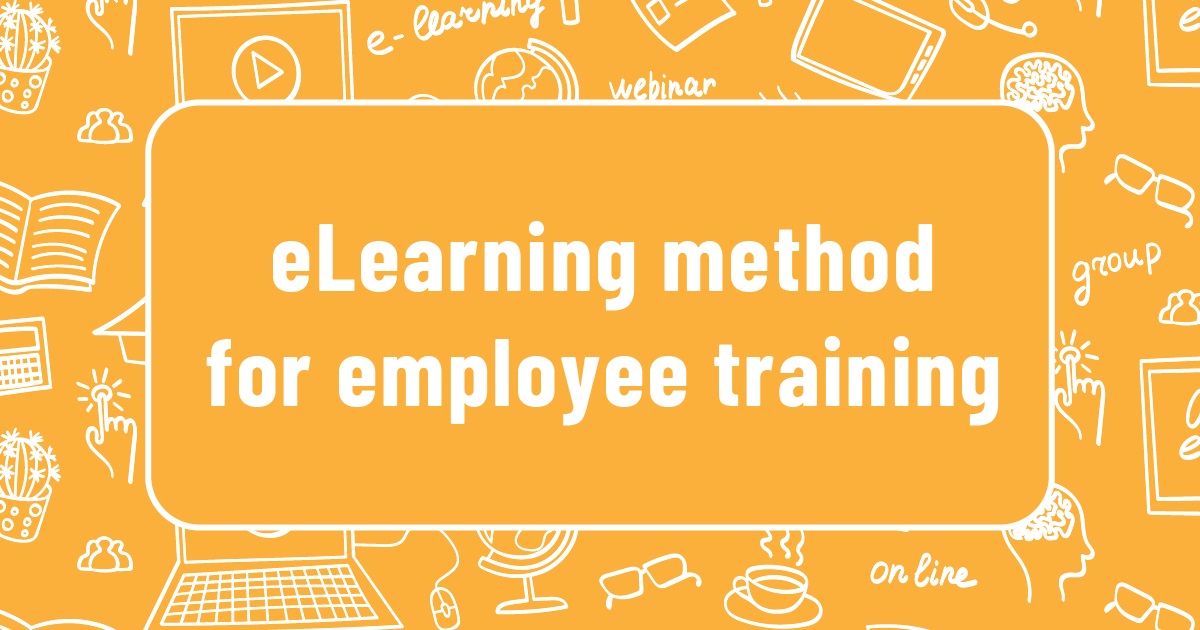Should you introduce e-learning training? Explaining the advantages and selection points
Should you introduce e-learning training? Explaining the advantages and selection points
Due to various social conditions, are there any managers or staff members who would like to conduct in-house training as efficiently as possible online?
This article provides an overview of e-learning training and its merits, and introduces the process of implementing e-learning training and points for selecting a system.
Content
- What is e-learning training?
- Benefits of e-learning training for companies
- Disadvantages of implementing e-learning training for companies
- Flow of e-learning training implementation
- Points for choosing a learning management system
- E-learning is becoming an essential part of our daily lives.
- Summary
What is e-learning training?

E-learning training is a type of training that is received remotely via a PC or smartphone connected to the Internet. The system itself has existed since the dawn of the Internet in 1990, and at that time it was called CBT (Computer Based Training).
The "e" in e-learning is an acronym for "electric," meaning "electronic," and e-learning training, as it is written, refers to training conducted through electronic media.
Benefits of e-learning training for companies

As the trend toward online learning accelerates in all fields, more and more companies are adopting e-learning training. In considering the introduction of e-learning, many people may want to know what benefits can be gained by adopting it.
Here are four advantages for companies to implement e-learning training.
Cost reduction in transportation, accommodation, and venue expenses
By introducing e-learning, it is possible to reduce the costs previously incurred in holding training.
For example, when conducting "group training", participants need to gather at one venue to receive the training. If your company has a nationwide network, you will have to pay for transportation and accommodation, which can be a big expense. Also, if there are a large number of participants, a large venue must be reserved to accommodate them.
E-learning training eliminates the need for transportation and accommodation costs, which can significantly reduce costs.
No need to arrange instructors.
E-learning training is a training program in which you go through an online program with the content already fixed. Therefore, there is no need to arrange for a special lecturer or instructor to teach the content.
It is a big advantage that you don't have to go through the hassle of finding high quality instructors unless you have a network of contacts, especially if the training is for specialized content. In addition, there is no need to pay an honorarium to the lecturer.
Uniform quality of instructors and education
With e-learning training, learning is not dependent on the level of the instructor when taking the same course. Therefore, there is no variation in instructors or quality of learning depending on the region or the year of the course. Since the content of instruction is homogenized, learning above a certain level is guaranteed.
Easy to manage progress
E-learning makes it easier to manage the progress of learning. The advantage of e-learning is that it makes it easier to grasp the overall picture of the learning process and monitor the progress, since both the host and the participants can check from the management screen how far they have come. This makes it easier to grasp the overall picture of the learning process and to monitor the progress. It also clarifies the issues that need to be addressed each time and facilitates subsequent learning.

Disadvantages of implementing e-learning training for companies

While there are many advantages to using e-learning, there are also some disadvantages. It is important to understand the challenges that are unique to online e-learning.
Here are four disadvantages of implementing e-learning training for companies.
Initial and monthly fees are required
When implementing e-learning training, you will need to pay an initial fee and a monthly fee. It depends on what kind of system or service you use, but in general, these two costs are incurred.
Compared to group training, there are no transportation or venue costs, but the overall cost alone may be higher than group training.
Internet access is required.
Since e-learning is training conducted via the Internet, it is essential to have an Internet environment if you want to take the course. PCs and smartphones are becoming more and more popular throughout the country, but the availability of the Internet environment and facilities varies depending on the circumstances of each family and individual.
In some cases, such as for pre-employment training, the cost of setting up the environment may be a burden for students who do not have an Internet connection at home.
Learning practical skills is difficult.
One of the disadvantages of e-learning training is that it is difficult to learn practical skills because it is mainly classroom training. It may be difficult to include training content that requires hands-on learning and collaboration with other trainees to produce results.
On the other hand, group training has the advantage of allowing multiple people to learn practical skills.
Difficult to keep students motivated
The advantage of online training is that you can learn anytime and anywhere, but it can also be a disadvantage. Since it is difficult to enforce the timing of the training, it may induce students to skip the training if their motivation is low.
It will be essential to take measures to keep the motivation of all students constant and aligned.

Flow of e-learning training implementation

The following is an explanation of the training implementation process for those who are thinking of introducing e-learning training.
If you don't know how to set up a program and want to know how to proceed systematically, please refer to this page.
STEP1: Determination of training content
The first thing to do is to determine the main purpose of the training and solidify the content. Identify the issues that the company is facing and the content that you want the specific target audience to learn, and then decide how the learning process will be carried out.
The main purpose of the training is to help each participant solve their own problems and improve their skills, as the content to be learned varies depending on the situation of each participant, whether they are a new employee or a manager.
STEP2: Decide on the Learning Management System (LMS)
Once you have determined your main objective, you can decide which learning management system (LMS) to use. There are a variety of services and systems released by different companies, including those that require you to prepare your own learning materials and those that provide them. Therefore, you must carefully select a system that fits your company's training objectives.
To make your e-learning training more effective, choose a system that allows you to visualize exactly what will happen after the program is completed.
STEP3: Determination of the training manager
Once the content and system have been finalized, decide on a training administrator. The right person will be the one who can organize the students and properly manage the progress of the training.
If there are too many students for one person to manage, one way is to form a team and work on a project. In this case, it is important to decide who will have the final responsibility and decision-making authority.
STEP4: Implementation of training
Once everything is ready, move on to the flow of actually conducting the training. With the manager in the lead, smoothly check the progress of the students and the submitted reports.
It is also important to take care of any delays in the progress of the students. e-Learning training is prone to differences in the progress and motivation of the students, so it is important to always be aware of how to balance the overall training.
STEP5: After-sales service
In all training programs, it is important to remember that the objective is not to conduct the training, but to learn how to apply what you have learned to your work. Therefore, make sure to follow up after the training is completed.
After the e-learning training is completed, it is recommended to provide a method to properly measure the effectiveness of the training, such as giving assignments to measure the level of learning. Another common method is to collect results and feedback through the submission of reports and questionnaires.
Points for choosing a learning management system

Many people may not know how to select a learning management system for promoting e-learning, since numerous products have been released by various companies.
To help you choose the right learning management system for your company, here are some points to consider when choosing a learning management system.
Are there types of educational materials that match your company's business and objectives?
When choosing a learning management system, check first to see if the materials are appropriate for your business and objectives. Using a system that deviates from your learning objectives will not be highly effective.
For example, if you want to conduct training for new employees through e-learning, choose a system that has a wide variety of content in that field, such as a system that allows for smooth communication and content that teaches the basics of being a member of society.
Is there an abundance of teaching materials?
When implementing a learning management system, it is important to select a system that has a large amount of learning materials and features. Once you have implemented a training system, it becomes very difficult to switch back to a new system. Also, there will be new initial costs, which will cause disadvantages in terms of cost.
It is recommended that you choose a system that has a wide range of training materials to accommodate a wide range of training content and take into account the possibility of changing the program.
Is it easy to operate?
Ease of use is a point that can be easily overlooked, but it is an important one. Ease of use is very important for both participants and organizers to ensure a smooth training experience.
Especially if you are taking the course to a generation that is not very familiar with computers and smartphones, it is recommended that you choose a system that has intuitive features.
Is there a motivation management function?
Managing student motivation is an important issue when conducting training online.
In order to keep motivation as constant as possible, it would be more effective if there is an "alert function" or some other feature to encourage students who tend to slack off.
E-learning is becoming an essential part of our daily lives.
In recent years, more and more companies are adopting or considering e-learning as a means of training. This is due to the fact that the quality of learning remains consistent and the time and effort required to prepare the program is reduced.
If you are planning to introduce e-learning training within your company, be sure to research the characteristics of each service or system and select the one that best suits your purpose. These systems are now indispensable for efficient in-house training.
Summary
In this article, we introduced e-learning training, the flow of training implementation, and points to consider when introducing it.
If you are thinking of introducing e-learning training, our "learningBOX" is a good choice. It is intuitive, easy to use, and offers a wealth of features at a low price.
Up to 10 people, including the administrator, can use this service for free. Free PlanIf you are interested in learning more about our products, please feel free to contact us.


- What is the current focus of training videos? The advantages of using them and points to consider when creating them
- [e-Learning System Satisfaction Survey] The results of a survey of 1,011 training staff are now available!
Comment ( 0 )
Trackbacks are closed.








No comments yet.